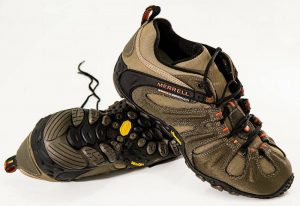Quick Navigation
Overview
As a matter of fact, great-fitting hiking boots need to get accustom with your feet. If you choose to wear a new pair of hiking boots, you’ll enjoy many comfortable benefits it has in miles on the trail together.
There are different types of hiking boots which makes boots take different break-in times. Light hikers may feel perfect right out while hiking, while burly leather models may require weeks to sync in with your feet. The leather of the hiking boots needs time to soften up so your boots and feet can get used to one another. See how to find the ideal shoes for hiking.
The break-in process won’t turn a poor fit hiking boot into a good one. Hiking and climbing boots can give rise to or shatter your day on the paths. When hiking boots fit suitably, you can go for miles and still feel good at the end of the day. When they don’t suit well they cause foot pain, it can bring about a really bad experience of hiking. If you’re wondering, how fit should my hiking boots fit? Or you have foot injury and you are looking for the best hiking footwear, you’re in the right place.
There are multiple types of hiking boots vacant which are light hiking shoes, backpacking boots and mountaineering boots. To discover the best hiking boots for you, make sure you match your hiking purposes with your footwear.
The best hiking boots will fit your feet flawlessly, attaching your foot securely without squeezing it in the boots.
Your hiking boots should give the right level of curve support for your feet, especially if you have a foot injury. If the curve assistance in your hiking boots isn’t enough, add arch aid supplements for hiking boots.
Other components to examine when you’re looking for the most comfortable hiking boots include the flex of the boots, breathability, outsole tread, and weight.
Few precautions to take while wearing a hiking boot
Wear your hiking boots inside the house
Wear your socks the insoles you’ll be wearing on the trail and tie your hiking and climbing boots comfortable and fitted, but not too tight. Make sure the tongues and gussets of your boots are straight. Your new hiking and climbing boots will be a little stiff at first, which is normal.
Walk around the block and town
Make sure your boots feel good and comfortable at each stage before increasing and extending the distance.
Put on a backpack and hit the trail
Off pavement is where serious breaking in happens. Be sure you continuously increase both weight and mileage throughout this stage.
Always read and follow the producer’s guidelines. Even if you don’t find break-in tips, you’ll learn about proper care and use of hiking boots.
One of the terrible experience of rock climbing can be breaking in a new pair of hiking shoes. Frequently, hiking shoes can be so painful that climbers and hikers off them after each route or boulder problem becomes a requirement. Part of this arises from the old-school psyche that climbing and hiking shoes have to fit tighter. This certainly isn’t credible, and locating a shoe that suits your foot correctly and comfortably can solve a lot of unnecessary pain when you’re out at the crag.
The following procedures will not stretch any of the rubber parts of your climbing and hiking shoe. However, they will work to stretch a leather upper and give your toes extra room where they need it vastly.
Intertwine up your new shoelace
Take your new hiking and climbing shoe out of the box. Make sure you remove all packaging and stickers that might be in the shoe or on the sole. Put your foot into the shoe and lace it comfortably but not too tight.
Get into a hot shower. For real, with your new climbing and hiking shoes on, get into a hot shower. Make sure that the bee climbing shoes get completely soaked through with hot water while you wear them on your foot. It also helps to shake your toes to begin to slope and mould the leather.
Walk around with the climbing shoes on your feet
With the shoes still wet, after getting out of the shower stroll around your house. Retain them on until they begin to show signs like they are drying up.
If your shoes only need a small amount of sloping, the ice bag is the way to go. It is also easier to conform the amount you slope your shoes with the ice-bag technique. Few ice-bag method include.
Freeze your new climbing and hiking shoes
Pick two zip-lock bags (one for each shoe) and fill them each with water until they are approximately the size of your foot. Put the zip-lock bags filled with water into your hiking and climbing shoes and intertwine them loosely around the bags. Lay your climbing shoes into the freezer and leave them overnight.
Let your shoes melt or soften
Take the shoes out of the freezer and let them soften. The water will have enlarged as it froze, thereby stretching the hiking shoe in the process. This process works in smaller increments than the shower procedure. However, if your shoes need more stretching faster, opt for the shower.
Repeat as needed
It may take a few repetitions of the method to get your hiking shoes to the degree where the upper is stretched to the level where it is comfortable on your foot whenever you wear them.
Conclusion
Hiking boots can be other rubber or leather, they must be lace-up appropriately. While choosing your hiking and climbing boots, endeavour to examine the outsole, breathability and weight. There are also a few times on what to do to make your hiking shoes fit comfortably in this article. We hope this article has answered all the questions you have about hiking and climbing shoes.
See all you need to know about eco-friendly shoes‘

